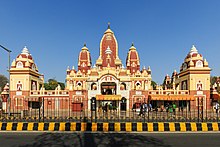The Laxminarayan Mandir is a Hindu temple located in New Delhi, India. The presiding deity in the temple is Laxminarayan i.e., Vishnu along with his consort Lakshmi. The temple was inaugurated by Mahatma Gandhi. Gandhi ensured that members of all castes would be allowed in the temple.[1] It was built by Jugal Kishore Birla[2] from 1933 and 1939. There are also small shrines on the sides dedicated to Shiva, Ganesha, Hanuman and Buddha.[3]
| Laxminarayan Temple | |
|---|---|
Laxmi Narayan Temple | |
 | |
| Religion | |
| Affiliation | Hinduism |
| Deity | Laxmi Narayan (Vishnu with his consort Lakshmi) |
| Festivals | Janmashtami, Diwali |
| Location | |
| Location | New Delhi |
| Country | India |
| Geographic coordinates | 28°37′58″N 77°11′56″E / 28.6327°N 77.1989°E |
| Architecture | |
| Type | Nagara style of Hindu temple architecture |
| Creator | Baldeo Das Birla |
| Completed | 1939 |
It was the first large Hindu temple built in Delhi and is often called Birla Mandir due to being constructed by the Birla family. The temple is spread over 3 hectares (7.5 acres), adorned with many shrines, fountains, and a large garden with Hindu and Nationalistic sculptures, and also houses Geeta Bhawan for discourses. The temple is one of the major attractions of Delhi and attracts thousands of devotees on the festivals of Janmashtami and Diwali.
History
editThe construction of the temple dedicated to Laxmi Narayana started in 1933, built by industrialist and philanthropist, Baldeo Das Birla and his son Jugal Kishore Birla of the Birla family, thus, the temple is also known as Birla Temple. The foundation stone of the temple was laid by Jat Maharaj Udaybhanu Singh. The temple was built under guidance of Pandit Vishwanath Shastri.[4] The concluding ceremony and Yagna were performed by Swami Keshavanandji.[5][3][6]
Gandhi inaugurated the temple and ensured that it allows members of all castes.[1]
This is the first of a series of temples built by the Birlas in many cities of India, which are also often called Birla Temple.
Architecture
editIts architect was Sris Chandra Chatterjee, a leading proponent of the "Modern Indian Architecture Movement."[7] The architecture was influenced heavily by the principles of the Swadeshi movement of the early twentieth century and the canonical texts used. The movement did not reject the incorporation of new construction ideas and technologies. Chatterjee extensively used modern materials in his buildings.
The three-storied temple is built in the northern or Nagara style of temple architecture. The entire temple is adorned with carvings depicting the scenes from golden yuga of the present universe cycle. More than a hundred skilled artisans from Benares, headed by Acharya Vishvanath Shastri, carved the icons of the temple. The highest shikhara of the temple above the sanctum sanctorum is about 49 m (160 feet) high. The temple faces the east and is situated on a high plinth. The shrine is adorned with fresco paintings depicting Shastri's life and work. The icons of the temple are in marble brought from Jaipur. Kota stone from Makarana, Agra, Kota, and Jaisalmer was used in the construction of the temple premises. The Geeta Bhawan to the north of the temple is dedicated to Krishna. Artificial landscape and cascading waterfalls add to the beauty of the temple.[8]
Temple
editThe main temple houses statues of Narayan and Lakshmi. There are other small shrines dedicated to Shiva, Ganesha and Hanuman. There is also a shrine dedicated to Buddha. The left side temple shikhar (dome) houses Devi Durga, the goddess of Shakti, the power. The temple is spread over an area of 30,000 square metres (7.5 acres) approximately and the built up area is 2,100 square metres (0.52 acres).
Location
editThe temple is located on the Mandir Marg, situated west of the Connaught Place in New Delhi. The temple is easily accessible from the city by local buses, taxis and auto-rickshaws. The nearest Delhi Metro station is R. K. Ashram Marg metro station, located about 2 km away. Also on the same road lies the New Delhi Kalibari.
See also
editGallery
edit-
Shivaji statue with a verse by Poet Bhushan
-
Flower Shop
-
Dharmashala
-
South Indian style Gopuram
-
Buddha Vihar
References
edit- ^ a b Kajri Jain (2021). Gods in the Time of Democracy. Duke University Press. p. 47.
- ^ Corporation, Delhi Tourism and Transportation Development. ":: Delhi Tourism - Birla Mandir ::". www.delhitourism.gov.in. Retrieved 20 November 2018.
- ^ a b "Making history with brick and mortar". Hindustan Times. 15 September 2011. Archived from the original on 5 December 2012.
- ^ Bulletin, Expert. "Birla Mandir – Lakshmi Narayan Temple Delhi - Expert Bulletin". Retrieved 16 October 2016.
- ^ "Archived copy". Archived from the original on 3 July 2014. Retrieved 19 September 2014.
{{cite web}}: CS1 maint: archived copy as title (link) - ^ "Birla Temple Delhi- Birla Mandir in Delhi, Laxmi Narayan Mandir Delhi, Laxminarayan Temple New Delhi India". Retrieved 16 October 2016.
- ^ A Concise History of Modern Architecture in India, Jon T. Lang, Orient Blackswan, 2002, p. 27
- ^ "Birla Mandir:About the Temple". Archived from the original on 13 April 2012. Retrieved 16 October 2016.

